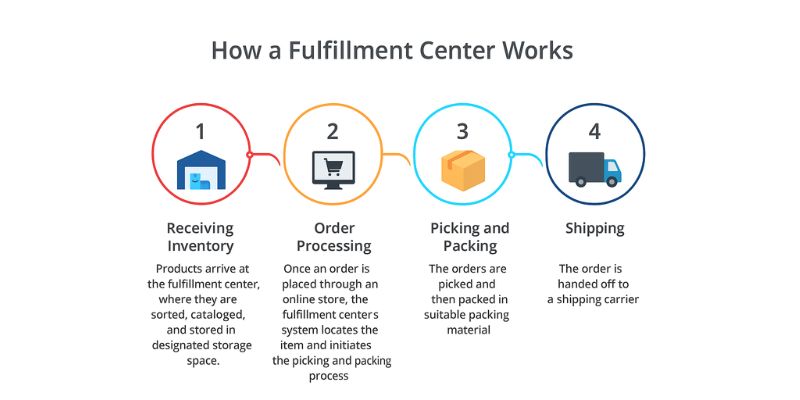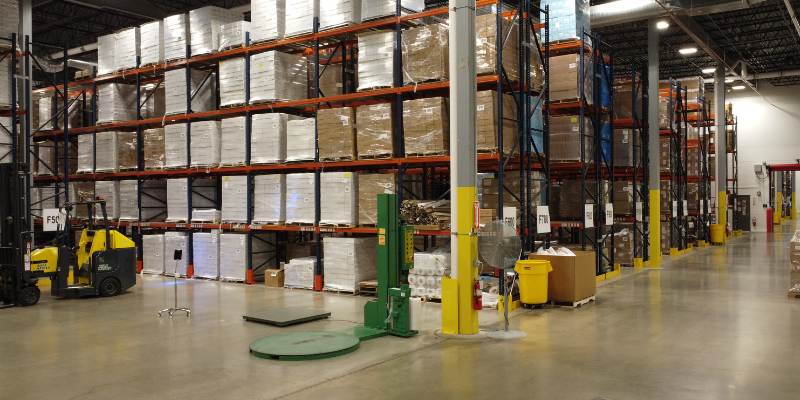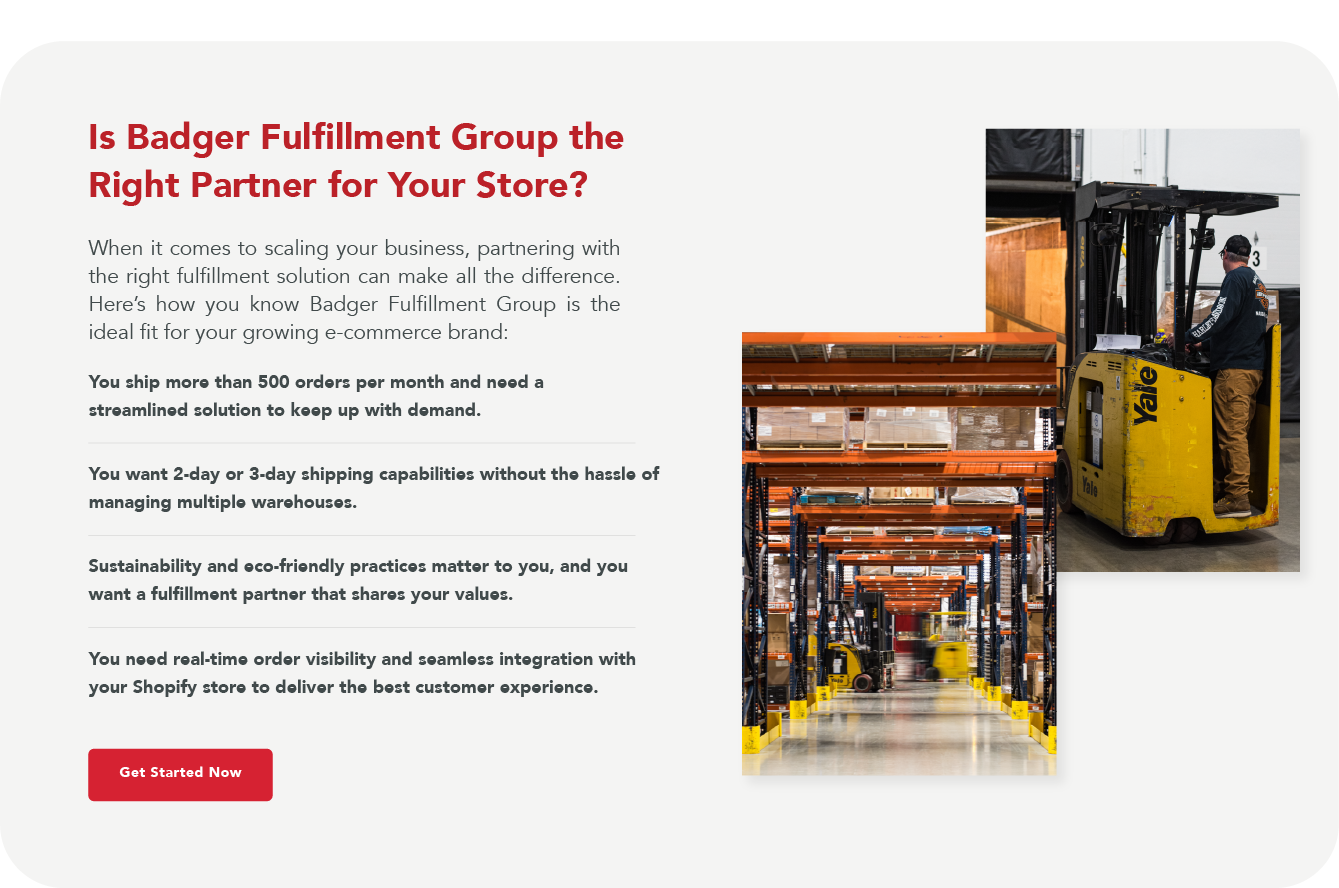A fulfillment center is a specialized facility where e-commerce businesses store inventory, process customer orders, and manage shipping. Unlike traditional warehouses, which focus primarily on storage, fulfillment centers actively handle the logistics required to pick, pack, and ship orders directly to customers. The goal of a fulfillment center is to streamline the entire order fulfillment process, helping businesses meet growing customer demands for fast and accurate deliveries.
A well-run fulfillment center does more than move products efficiently. It becomes an extension of your brand experience by ensuring each order is handled with speed, precision, and care. With integrated systems that sync directly with e-commerce platforms, businesses gain real-time visibility into inventory levels and shipping status. This level of operational support not only reduces overhead and shipping errors but also allows business owners to focus on scaling their brand rather than managing logistics.
Key Sections:
- Fulfillment Center vs. Warehouse vs. Distribution Center
- How a Fulfillment Center Works
- Benefits of Using a Fulfillment Center
- What to Know About Fulfillment Centers
- Challenges of Using a Fulfillment Center
- The Cost of Using a Fulfillment Center
- How to Calculate ROI of Using a Fulfillment Center
- How to Choose the Right Fulfillment Center for Your Business
Fulfillment Center vs. Warehouse vs. Distribution Center
Although fulfillment centers, warehouses and distribution centers may seem similar at a glance, each serves a unique function within the supply chain. Understanding these differences is essential for choosing the right logistics solution based on your business model and customer expectations.
A fulfillment center is a highly active environment designed to handle the complete order lifecycle for ecommerce businesses. Its core function is to receive inventory, manage real-time order processing, pick and pack products and ship them directly to end customers. These centers are equipped with systems that integrate seamlessly with online storefronts, ensuring fast and accurate delivery. Fulfillment centers are optimized for speed, flexibility and scalability, making them ideal for brands that need responsive and customer-focused logistics support.
Warehouses, by contrast, are primarily used for long-term storage. They are built to hold large volumes of inventory that may not need to move quickly or frequently. Most warehouse operations involve palletized goods and bulk inventory storage for manufacturers, wholesalers or large retailers. There is little emphasis on day-to-day order fulfillment, and typically no direct connection to online sales channels. While warehouses serve an important role in supply chain stability, they are not designed for the fast pace and order complexity of modern ecommerce.
Distribution centers operate as strategic hubs where products are received, sorted and redistributed to various retail locations or regional depots. They are a critical link in the supply chain for businesses with multiple physical locations. While they may provide short-term storage, their main function is to move goods in and out efficiently at a high volume. Distribution centers are built around transportation logistics rather than individual order fulfillment, and are more aligned with wholesale or retail operations than direct-to-consumer sales.
Fulfillment centers stand apart by combining the agility of real-time order processing with the infrastructure needed to scale. They offer a suite of services that allow ecommerce brands to delegate logistics while maintaining visibility, accuracy and control. From inventory receiving to last-mile delivery, a fulfillment center supports every step of the customer experience and adapts as your business grows.
How a Fulfillment Center Works
The fulfillment process is a critical component of any ecommerce operation. A well-run fulfillment center ensures orders are accurate, on time and aligned with your brand’s standards. It also gives your team the freedom to focus on growth rather than logistics. Below is a detailed overview of how the process works from the moment inventory arrives to the final delivery to the customer.
- Receiving Inventory: When products arrive at the fulfillment center they are carefully inspected for damage and accuracy. Each item is then cataloged and entered into an inventory management system. After that the products are stored in an organized layout that supports fast and efficient retrieval. Items are placed in specific bins or shelving locations depending on size and frequency of use. This structured approach ensures that every item is easy to locate when orders come in.
- Order Processing: Once a customer places an order on your ecommerce store the fulfillment center’s system immediately receives the order. It checks inventory levels and identifies the exact location of the item in the warehouse. A pick list is generated in real time and queued for the next available warehouse associate or automated system. This step keeps operations moving swiftly and helps reduce errors in order fulfillment.
- Picking and Packing: A warehouse associate retrieves the ordered items from their assigned locations and brings them to a packing station. The products are verified for accuracy and then packed with care using protective materials suited to the item type. Packing may also include custom inserts or branded materials that reflect your company’s image. Once the order is packed a shipping label is printed and applied and the package is prepared for carrier pickup.
- Shipping: After packing the order is moved to the outbound shipping area. From there it is handed off to the designated carrier for delivery. The fulfillment center selects the best shipping option based on factors like destination cost and delivery timeframe. Customers automatically receive tracking details so they know exactly when to expect their package. This final step completes the cycle and helps reinforce a reliable and consistent customer experience.

What to Know About Fulfillment Centers
Fulfillment Centers Fuel E-Commerce Success
US ecommerce sales are projected to surpass one trillion dollars in 2024, marking a pivotal moment in the continued growth of online retail. Within the ecommerce supply chain, fulfillment centers play a central role by bridging the gap between suppliers, ecommerce businesses and end customers. By managing the logistics infrastructure and overseeing every stage of the order fulfillment process, these facilities allow brands to shift their focus toward high-impact areas such as marketing, product innovation and customer engagement. This operational support helps businesses scale with confidence while delivering a seamless experience to their customers.
Order Processing and Management
Fulfillment centers streamline the order management process by organizing and tracking orders from start to finish. With advanced technology and automation, they can accurately manage high volumes of orders, making sure that each product is picked, packed, and shipped without errors. This streamlined process saves time, lowers costs, and improves customer satisfaction.
Scalability for Growing Businesses
For e-commerce businesses that experience seasonal peaks or rapid growth, fulfillment centers provide flexibility without the need for additional resources. By using a fulfillment center, businesses can scale operations to meet increased demand without investing in extra storage space, equipment, or labor, making expansion simpler and more cost-effective.
Handling Returns
Managing returns can be challenging for e-commerce businesses, but fulfillment centers offer dedicated return processing services that streamline this aspect. By handling returns, restocking, and customer communication, fulfillment centers alleviate the burden on businesses and help maintain a positive customer experience. This enables businesses to focus on creative, growth-oriented aspects while their fulfillment operations are efficiently managed.
Benefits of Using a Fulfillment Center
A fulfillment center plays a vital role in helping ecommerce businesses operate more efficiently, scale with confidence and deliver exceptional customer experiences. By outsourcing key logistics functions such as inventory storage, order processing, packing, shipping and returns, brands can eliminate costly operational overhead and streamline their day-to-day workflows. Whether you are an emerging brand looking to grow or an established business aiming to improve margins and performance, the right fulfillment partner becomes an extension of your team. With the infrastructure, expertise and flexibility to adapt to changing demands, fulfillment centers enable ecommerce businesses to remain agile and competitive in an increasingly fast-paced market. Here are seven core benefits that make fulfillment centers a valuable asset for long-term success.
- Enhanced Customer Satisfaction: Fulfillment centers ensure faster and more accurate deliveries. When customers receive their orders on time and in excellent condition, it builds trust and encourages repeat purchases. This reliability strengthens your brand’s reputation and drives long-term customer loyalty.
- Time and Cost Efficiency: Outsourcing fulfillment eliminates the need to manage warehouse staff, coordinate shipping logistics or maintain inventory systems in-house. This reduction in operational burden saves both time and money, allowing your team to focus on business development, marketing and growth initiatives.
- Access to Fulfillment Expertise: Fulfillment centers are run by logistics professionals who understand shipping regulations, packaging standards and seasonal volume shifts. Their expertise helps reduce costly errors and ensures that each order is processed accurately and efficiently.
- Smarter Inventory Management: With real-time inventory tracking, businesses gain full visibility into product availability and stock movement. This allows for better forecasting, fewer stockouts and reduced storage of excess or obsolete inventory.
- Scalability and Flexibility: Fulfillment centers are built to accommodate changing order volumes, making it easy to scale operations during seasonal surges, product launches or periods of rapid growth. This flexibility supports business expansion without requiring additional investment in infrastructure.
- Seamless Multi-Channel Integration: Modern fulfillment centers integrate directly with ecommerce platforms, marketplaces and POS systems. This ensures orders from all sales channels are synced into a centralized system, reducing errors and improving fulfillment speed across platforms.
- Streamlined Returns Management: Many fulfillment centers offer end-to-end returns processing, helping businesses manage restocking, quality checks and customer refunds. This simplifies one of the most challenging aspects of ecommerce and ensures a smooth experience for customers returning items.
Challenges of Using a Fulfillment Center
While fulfillment centers offer numerous advantages, there are also challenges to consider. From the potential loss of control over fulfillment operations to integration complexities, using a fulfillment center requires careful planning to maintain service quality and align with business needs. Here’s a look at some common challenges that businesses may encounter when outsourcing fulfillment.
- Loss of Control over Fulfillment Operations: One challenge of outsourcing fulfillment is the reduced control over day-to-day operations. Entrusting an external provider with the fulfillment process means that businesses rely on the provider’s accuracy, timing, and service quality. Open communication with the fulfillment provider can help mitigate these concerns.
- Integration Complexity: Integrating a fulfillment center’s technology with an online store’s system can be complex and may require adjustments. Proper integration is essential to ensure real-time updates, accurate inventory levels, and seamless order processing. Choosing a fulfillment center with strong technical capabilities or apps that integrate with your ecommerce store can help overcome these challenges.
- Costs for Small Businesses: While outsourcing to a fulfillment center can save costs for larger companies, it may not be as cost-effective for small businesses with lower order volumes. For smaller businesses, it’s essential to weigh the costs of fulfillment services against potential savings in time and resources.
- Dependency on Third-Party Performance: When outsourcing to a fulfillment center, a business’s reputation partly depends on the fulfillment provider’s performance. Delays, mistakes, or quality issues can impact customer satisfaction. Working with a reputable and reliable fulfillment partner is crucial to maintain service quality and uphold a positive brand image.
The Cost of Using a Fulfillment Center
Using a fulfillment center involves various costs that businesses should understand to make informed decisions. From storage fees to picking, packing, and shipping charges, these expenses can add up, but they also bring the potential for significant ROI through operational savings and scalability. Here’s a breakdown of typical fulfillment center costs and how to evaluate the return on investment.
Breakdown of Fulfillment Center Costs:
- Receiving and Storage Fees
- Picking and Packing Fees
- Shipping Fees
- Additional Services
How to Calculate ROI of Using a Fulfillment Center
Calculating the return on investment (ROI) for using a fulfillment center requires analyzing the costs of outsourcing against the savings in labor, storage, and shipping, as well as the potential for increased sales and improved customer satisfaction.
- Labor Savings: Consider the labor costs saved by outsourcing fulfillment. Calculate the monthly cost of employees currently handling fulfillment tasks (e.g., wages, benefits) and compare it to the monthly fees charged by the fulfillment center.
- Storage Savings: Storage fees in a fulfillment center are generally based on the amount of space or number of units stored. Calculate the cost of storage in-house (including rent, utilities, and other expenses) versus the storage fees charged by the fulfillment center. Many fulfillment centers have partnerships with shipping carriers, allowing for discounted rates. Compare your current shipping costs to those offered by the fulfillment center
ROI Calculation: Divide total savings by the fulfillment center’s monthly cost. Tracking these metrics over time helps businesses assess whether fulfillment center services provide consistent ROI, and adjustments can be made to improve budget allocation further.
How to Choose the Right Fulfillment Center for Your Business
Selecting the right fulfillment center is one of the most important decisions an ecommerce business can make. The fulfillment partner you choose will directly impact your shipping speed, order accuracy, customer satisfaction and operational costs. It is not simply about finding a company that can store and ship products, but about identifying a partner who understands your brand, adapts to your growth and integrates seamlessly with your systems. The ideal fulfillment center will support your current order volume while offering the scalability, technology and service needed to help you expand into new markets and channels. From location and turnaround times to technology and account support, there are several critical factors to evaluate when choosing a fulfillment solution that meets both your immediate needs and long-term goals.
- Range of Services Offered: A good fulfillment center offers a variety of services, including same-day shipping, custom packaging, and efficient returns handling. Matching services with business needs ensures a smooth order fulfillment process.
- Technology and Integration Capabilities: Ensure the fulfillment center’s technology can integrate seamlessly with the e-commerce platform for real-time updates, efficient inventory management, and streamlined operations.
- Customer Support and Communication: Strong customer support, having Account Managers within the warehouse and clear communication from your fulfillment center are essential for addressing any issues quickly and maintaining transparency in the fulfillment process.
- Scalability for Future Growth: As businesses grow, fulfillment centers should provide the scalability to handle higher order volumes and seasonal demand without service interruptions, making them an asset to long-term success.
Why Partner with Badger Fulfillment Group
At Badger Fulfillment Group, we do more than ship boxes. We become an extension of your brand. From our centrally located facility in Harvard, Illinois, we offer ecommerce businesses nationwide a streamlined fulfillment experience grounded in precision, visibility and personal service. Every order is managed within our warehouse by a dedicated account team who understands your products, your workflows and your customers.
Our technology integrates seamlessly with all major ecommerce platforms, giving you real-time inventory visibility and automated order syncing. Whether you need support for subscription boxes, Amazon FBA prep, or multi-channel fulfillment, our systems and people are built to scale with you. We offer flexible storage options, transparent pricing, same-day shipping and custom packaging capabilities tailored to your brand.
What truly sets Badger apart is our commitment to responsiveness. With just one degree of separation between our account managers and your product, we eliminate unnecessary layers and empower your business to grow without logistical bottlenecks. When you partner with Badger Fulfillment Group, you gain more than a 3PL. You gain a fulfillment partner invested in your success.



